Revisiontestbanks
On this page, you find all documents, package deals, and flashcards offered by seller RevisionTestBanks.
- 305
- 0
- 30
Community
- Followers
- Following
4 Reviews received
335 items
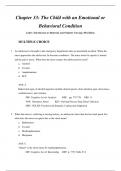
Test Bank for Introduction to Maternity and Pediatric Nursing 9th Edition by Gloria Leifer |Chapter 31-34|
Chapter 31: The Child with a Metabolic Condition Chapter 32: Childhood Communicable Diseases, Bioterrorism, Natural Disasters, and the Maternal–Child Patient Chapter 33: The Child with an Emotional or Behavioral Condition Chapter 34: Complementary and Alternative Therapies in Maternity and Pediatric Nursing
- Package deal
- • 4 items •
- Chapter 33: The Child with an Emotional or Behavioral Condition • Exam (elaborations)
- Chapter 34: Complementary and Alternative Therapies in Maternity and Pediatric Nursing • Exam (elaborations)
- Chapter 31: The Child with a Metabolic Condition • Exam (elaborations)
- Chapter 32: Childhood Communicable Diseases, Bioterrorism, Natural Disasters, and the Maternal–Child Patient • Exam (elaborations)
Chapter 31: The Child with a Metabolic Condition Chapter 32: Childhood Communicable Diseases, Bioterrorism, Natural Disasters, and the Maternal–Child Patient Chapter 33: The Child with an Emotional or Behavioral Condition Chapter 34: Complementary and Alternative Therapies in Maternity and Pediatric Nursing

Chapter 32: Childhood Communicable Diseases, Bioterrorism, Natural Disasters, and the Maternal–Child Patient
MULTIPLE CHOICE 1. The nurse is preparing to administer immunizations at a well-child clinic. Which method of administration will the nurse implement? a. DTaP subcutaneously b. Hib vaccine prepared in a separate syringe c. Varicella intramuscularly d. Varicella 1 week after the MMR vaccine ANS: B Hib vaccine must be given in a separate syringe from other vaccines administered at the same time. DIF: Cognitive Level: Knowledge REF: p. 757 OBJ: 7 TOP: Hib KEY: Nursing Pr...
- Package deal
- Exam (elaborations)
- • 13 pages •
MULTIPLE CHOICE 1. The nurse is preparing to administer immunizations at a well-child clinic. Which method of administration will the nurse implement? a. DTaP subcutaneously b. Hib vaccine prepared in a separate syringe c. Varicella intramuscularly d. Varicella 1 week after the MMR vaccine ANS: B Hib vaccine must be given in a separate syringe from other vaccines administered at the same time. DIF: Cognitive Level: Knowledge REF: p. 757 OBJ: 7 TOP: Hib KEY: Nursing Pr...
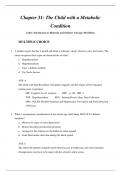
Chapter 31: The Child with a Metabolic Condition
MULTIPLE CHOICE 1. A mother reports that her 4-month-old infant is lethargic, sleeps 18 hours a day, and snores. The nurse recognizes these signs are characteristic of what? a. Hypothyroidism b. Hyperthyroidism c. Type 1 diabetes mellitus d. Tay-Sachs disease ANS: A The infant with hypothyroidism will appear sluggish, and the tongue will be enlarged, causing noisy respiration. DIF: Cognitive Level: Analysis REF: p. 726 OBJ: 3 TOP: Hypothyroidism KEY: Nursing Process ...
- Package deal
- Exam (elaborations)
- • 15 pages •
MULTIPLE CHOICE 1. A mother reports that her 4-month-old infant is lethargic, sleeps 18 hours a day, and snores. The nurse recognizes these signs are characteristic of what? a. Hypothyroidism b. Hyperthyroidism c. Type 1 diabetes mellitus d. Tay-Sachs disease ANS: A The infant with hypothyroidism will appear sluggish, and the tongue will be enlarged, causing noisy respiration. DIF: Cognitive Level: Analysis REF: p. 726 OBJ: 3 TOP: Hypothyroidism KEY: Nursing Process ...
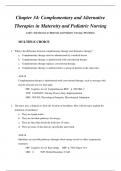
Chapter 34: Complementary and Alternative Therapies in Maternity and Pediatric Nursing
MULTIPLE CHOICE 1. What is the difference between complementary therapy and alternative therapy? a. Complementary therapy must be administered by a medical doctor. b. Complementary therapy is administered with conventional therapy. c. Complementary therapy replaces conventional therapy. d. Complementary therapy is administered to a group of patients at the same time. ANS: B Complementary therapy is administered with conventional therapy, such as massage with muscle relaxants fo...
- Package deal
- Exam (elaborations)
- • 10 pages •
MULTIPLE CHOICE 1. What is the difference between complementary therapy and alternative therapy? a. Complementary therapy must be administered by a medical doctor. b. Complementary therapy is administered with conventional therapy. c. Complementary therapy replaces conventional therapy. d. Complementary therapy is administered to a group of patients at the same time. ANS: B Complementary therapy is administered with conventional therapy, such as massage with muscle relaxants fo...

Test Bank for Introduction to Maternity and Pediatric Nursing 9th Edition by Gloria Leifer |Chapter 26-30|
Chapter 26: The Child with a Cardiovascular Disorder Chapter 27: The Child with a Condition of the Blood, Blood-Forming Organs, or Lymphatic System Chapter 28: The Child with a Gastrointestinal Condition Chapter 29: The Child with a Genitourinary Condition Chapter 30: The Child with a Skin Condition
- Package deal
- • 5 items •
- Chapter 26: The Child with a Cardiovascular Disorder • Exam (elaborations)
- Chapter 27: The Child with a Condition of the Blood, Blood-Forming Organs, or Lymphatic System • Exam (elaborations)
- Chapter 29: The Child with a Genitourinary Condition • Exam (elaborations)
- Chapter 30: The Child with a Skin Condition • Exam (elaborations)
- Chapter 28: The Child with a Gastrointestinal Condition • Exam (elaborations)
Chapter 26: The Child with a Cardiovascular Disorder Chapter 27: The Child with a Condition of the Blood, Blood-Forming Organs, or Lymphatic System Chapter 28: The Child with a Gastrointestinal Condition Chapter 29: The Child with a Genitourinary Condition Chapter 30: The Child with a Skin Condition

Chapter 33: The Child with an Emotional or Behavioral Condition
MULTIPLE CHOICE 1. An adolescent is brought to the emergency department after an automobile accident. When the nurse approaches the adolescent, he becomes combative. The nurse notes his speech is slurred and his gait is ataxic. What does the nurse suspect the adolescent has used? a. Alcohol b. Cocaine c. Amphetamines d. PCP ANS: A Behavioral signs of alcohol ingestion include slurred speech, short attention span, drowsiness, combativeness, and violence. DIF: Cognitive Level: ...
- Package deal
- Exam (elaborations)
- • 14 pages •
MULTIPLE CHOICE 1. An adolescent is brought to the emergency department after an automobile accident. When the nurse approaches the adolescent, he becomes combative. The nurse notes his speech is slurred and his gait is ataxic. What does the nurse suspect the adolescent has used? a. Alcohol b. Cocaine c. Amphetamines d. PCP ANS: A Behavioral signs of alcohol ingestion include slurred speech, short attention span, drowsiness, combativeness, and violence. DIF: Cognitive Level: ...
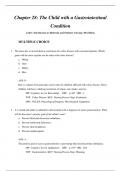
Chapter 28: The Child with a Gastrointestinal Condition
MULTIPLE CHOICE 1. The nurse has reviewed dietary restrictions for celiac disease with concerned parents. Which grain will the nurse explain can be eaten with celiac disease? a. Wheat b. Oats c. Barley d. Rice ANS: D Rice is a gluten-free grain that can be eaten by children afflicted with celiac disease. These children will have a lifelong restriction of wheat, oats, barley, and rye. DIF: Cognitive Level: Knowledge REF: p. 667 OBJ: 4 TOP: Celiac Disease KEY: Nursing P...
- Package deal
- Exam (elaborations)
- • 17 pages •
MULTIPLE CHOICE 1. The nurse has reviewed dietary restrictions for celiac disease with concerned parents. Which grain will the nurse explain can be eaten with celiac disease? a. Wheat b. Oats c. Barley d. Rice ANS: D Rice is a gluten-free grain that can be eaten by children afflicted with celiac disease. These children will have a lifelong restriction of wheat, oats, barley, and rye. DIF: Cognitive Level: Knowledge REF: p. 667 OBJ: 4 TOP: Celiac Disease KEY: Nursing P...
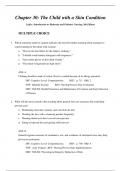
Chapter 30: The Child with a Skin Condition
MULTIPLE CHOICE 1. Which statement made by a parent indicates the need for further teaching about strategies to control itching for the infant with eczema? a. “Wool is the best fabric for the infant‘s clothing.” b. “I should avoid laundry detergents with fragrances.” c. “I put cotton gloves on the infant‘s hands.” d. “The infant‘s fingernails are kept short.” ANS: A Clothing should be made of cotton. Wool is avoided because of its allergy potential. DIF:...
- Package deal
- Exam (elaborations)
- • 16 pages •
MULTIPLE CHOICE 1. Which statement made by a parent indicates the need for further teaching about strategies to control itching for the infant with eczema? a. “Wool is the best fabric for the infant‘s clothing.” b. “I should avoid laundry detergents with fragrances.” c. “I put cotton gloves on the infant‘s hands.” d. “The infant‘s fingernails are kept short.” ANS: A Clothing should be made of cotton. Wool is avoided because of its allergy potential. DIF:...
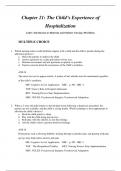
Test Bank for Introduction to Maternity and Pediatric Nursing 9th Edition by Gloria Leifer |Chapter 21-25|
Chapter 21: The Child’s Experience of Hospitalization Chapter 22: Health Care Adaptations for the Child and Family Chapter 23: The Child with a Sensory or Neurological Condition Chapter 24: The Child with a Musculoskeletal Condition Chapter 25: The Child with a Respiratory Disorder
- Package deal
- • 5 items •
- Chapter 21: The Child’s Experience of Hospitalization • Exam (elaborations)
- Chapter 23: The Child with a Sensory or Neurological Condition • Exam (elaborations)
- Chapter 24: The Child with a Musculoskeletal Condition • Exam (elaborations)
- Chapter 22: Health Care Adaptations for the Child and Family • Exam (elaborations)
- Chapter 25: The Child with a Respiratory Disorder • Exam (elaborations)
Chapter 21: The Child’s Experience of Hospitalization Chapter 22: Health Care Adaptations for the Child and Family Chapter 23: The Child with a Sensory or Neurological Condition Chapter 24: The Child with a Musculoskeletal Condition Chapter 25: The Child with a Respiratory Disorder
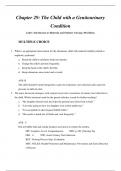
Chapter 29: The Child with a Genitourinary Condition
MULTIPLE CHOICE 1. What is an appropriate intervention for the edematous child with reduced mobility related to nephrotic syndrome? a. Reach the child to minimize body movements. b. Change the child‘s position frequently. c. Keep the head of the child‘s bed flat. d. Keep edematous areas moist and covered. ANS: B The child should be turned frequently to prevent respiratory tract infection and to prevent pressure on delicate skin. 2. The nurse discussed strategies with a pa...
- Package deal
- Exam (elaborations)
- • 13 pages •
MULTIPLE CHOICE 1. What is an appropriate intervention for the edematous child with reduced mobility related to nephrotic syndrome? a. Reach the child to minimize body movements. b. Change the child‘s position frequently. c. Keep the head of the child‘s bed flat. d. Keep edematous areas moist and covered. ANS: B The child should be turned frequently to prevent respiratory tract infection and to prevent pressure on delicate skin. 2. The nurse discussed strategies with a pa...

Chapter 18, Antidementia Drugs TEST BANK INTRODUCTORY CLINICAL PHARMACOLOGY 12TH EDITION By Susan M Ford
Chapter 50, Traditional Chemotherapy|| TEST BANK INTRODUCTORY CLINICAL PHARMACOLOGY 12TH EDITION By Susan M Ford
Chapter 38, Upper Gastrointestinal System Drugs TEST BANK INTRODUCTORY CLINICAL PHARMACOLOGY 12TH EDITION By Susan M Ford
Chapter 38, Upper Gastrointestinal System Drugs TEST BANK INTRODUCTORY CLINICAL PHARMACOLOGY 12TH EDITION By Susan M Ford